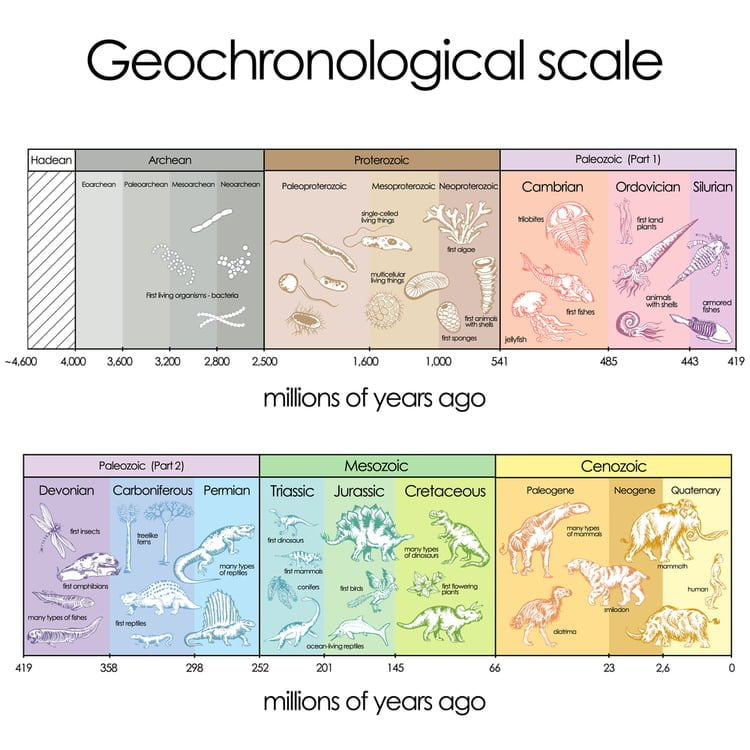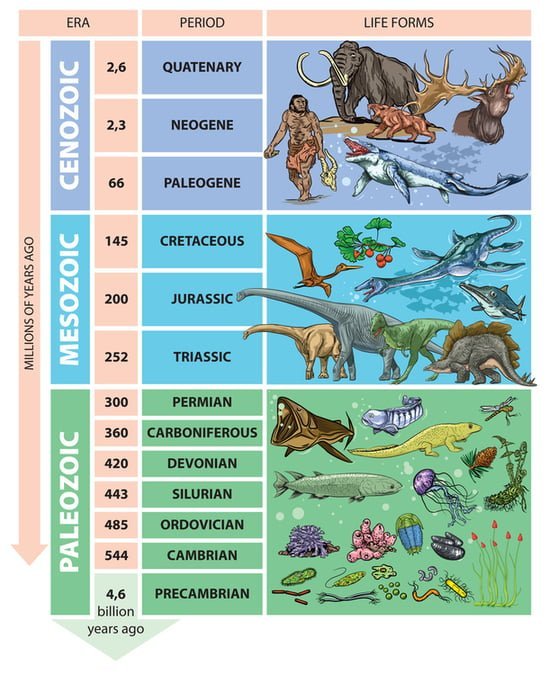The geologic time scale, sometimes called the GTS, is a standard representation of time. It goes back to the earliest evidence of Earth’s creation and describes up to the modern day.
It is divided into smaller units of time called eons, eras, periods, epochs, and ages. These stack inside each other to form the entire scale.
Why do we have this scale, and why is it organized the way that it is? Why is the geologic time scale important?
The geologic time scale helps scientists to group smaller increments of time by patterns in climate, evolution of life forms, and disruptions from extinction events. The assimilation of data points helps illustrate what the earth was like during this span of its history.
We’ll discuss in more how and why it was created and go over what we know about time so far. Let’s get started.
What is the Geologic Time Scale?
The modern international time scale that we know and use today officially began in 1961. This is when the International Union of Geological Sciences (IUGS) was created.
This group eventually created a committee that works specifically on the creation and upkeep of this time scale. However, the first ideas of rocks as markers for different times began as far back as Ancient Greece.
These ideas led to the first official organizing of rocks by age in the 1700s by scientists such as Thomas Burnet and Anton Moro.
Around the same time, Italian scientists Giovanni Targioni Tozzetti and Giovanni Arduino added to these ideas and separated all rocks into four units. These were the Primary, Secondary, Tertiary, and Quaternary units.
Today, only the Quaternary is still used in the modern time scale. The Tertiary was included until recently being split into two periods called the Paleogene and Neogene.
Why was Tertiary dropped? This could be an entire article on its own, so I recommend checking out this article from crgsoft.com which clarifies this in more detail.
As the name suggests, the geologic time scale comes from the geosciences and is used most by people within these fields. The process used to create the time scale is almost entirely geochronology. Geochronology means “earth-time-study.”
It is a science within geology that gives ages for rocks or other geologic events. This is mostly done by using isotopes or paleomagnetism. In paleontology, biostratigraphy can also be used to determine these ages.
In another article, we cover how paleontology interacts with various other branches of science. After reading this article, check out our topic on why paleontology is important.
Radioactive isotopes can give ages because of their half-lives. A radioactive isotope will decay into another isotope. When we measure how much of the new isotope is within our rock, we can figure out how old it must have been when the original radioactive isotope was formed.
Common examples are radiocarbon dating or uranium-lead dating. Paleomagnetism can give an age if a layer contains magnetic rocks. These rocks record the position of the magnetic poles at the time of their creation.
These positions change throughout time. Biostratigraphy orders rock layers based on the age of the animals found inside.

These methods are usually used together. This gives us the most accurate date possible. Using more than one method is especially important the farther back we go in time.
Radiocarbon dating may give an error margin of only a thousand years or so, but uranium-lead dating can be off by up to one or two million years. Likewise, biostratigraphy can only work if fossils are present even if the rocks are deposited during a time that we know these fossils occur.
This is why the geologic time scale is a huge international and interdisciplinary project that is still being researched today. Let’s take a look at the GTS and why it is still important today.
How is the Geologic Time Scale Used?
The current time scale has been researched for decades, with decisions made by geochemists, paleontologists, biostratigraphers, sedimentologists, and many more kinds of scientists.
Each of the time divisions is given a specific color once it has been named and divided. This helps organize the chart itself and is also used on geologic maps when coloring in rock formations.
The boundaries of periods in the geologic time scale are marked with a golden spike once the boundary is clearly defined. This is officially called a Global Boundary Stratotype Section and Point (GSSP).
For more on this subject, check out stratigraphy.org. There you can find more about how these rules have been applied over time as well as see an updated chart here.
As of today, there are 79 GSSPs placed around the world. These are important because they serve as a reference for everyone that has been agreed on by an international and interdisciplinary committee. These decisions can take quite some time to be accepted depending on how clear the transition boundary is.
One of the biggest discussions about the geologic time scale currently is the Anthropocene Epoch. There is no formal definition of the Anthropocene right now.
Scientists from different backgrounds use the term informally to refer to the most recent period of Earth’s history. Named for the Greek word for human, anthropos, it is used to demonstrate how humankind has affected the natural systems of the Earth.
Some people think there is no reason to make the Anthropocene an official period. Others think it should be, but cannot agree on when it should begin. This is why it can take a long time to create new divisions in time.
The Hadean, Archean, and Proterozoic Eons
Let’s start at the beginning and work our way toward the most recent time. The geologic time scale spans approximately 4.567 billion years!
The Hadean is the earliest eon of the time scale and is not separated into smaller divisions. It covers the earliest parts of Earth’s history up until the first living organisms came into existence around 4 billion years ago.
This marks the start of the second oldest eon, the Archean. The Archean lasted until 2.5 billion years ago and is split into four eras:
- Eoarchean
- Paleoarchean
- Mesoarchean
- Neoarchean
Notably, each of these eras begins with some development in the evolution of life.
The next eon is the Proterozoic which lasted from 2.5 billion to around 538 million years ago. It is split into three eras, which are the first to be split further into periods.
The first of these eras is the Paleoproterozoic which is split into four periods: The Siderian, Rhyacian, Orosirian, and Statherian. These periods are split based on developments in the oxygenation of our planet and the evolutionary history of eukaryotes, or multi-celled organisms.
The second era is the Mesoproterozoic which is split into the Calymmian, Ectasian, and Stenian periods. Most of the defining events of these periods are based on early tectonics and the formation of continental masses.
The final era of the Proterozoic is the Neoproterozoic, which contains the Tonian, Cryogenian, and Ediacaran periods.
The Tonian is also defined by continental developments, but the Cryogenian gets its name and definition from the glaciation that began at this time. The Ediacaran is also defined based on the evolution of life and is the oldest subdivision of time to be defined by a Global Boundary Stratigraphic Section and Point (GSSP).
These oldest parts of Earth’s history are commonly referred to by an unofficial title: The Precambrian.
The final eon of geologic time is the Phanerozoic. This is where life as we know it takes shape.
The Phanerozoic Eon: Where Modern Life Began
We’ll briefly discuss the major events in this eon. Spanning from around 538 million years to the modern day, it contains the most divisions of all of the eons with 3 eras, 12 periods, 38 epochs, and all 102 defined ages.
This eon is divided into three eras:
- Paleozoic
- Mesozoic
- Cenozoic
This marks the most rapid proliferation of life forms on Earth.
The Paleozoic Era
The Paleozoic begins with the Cambrian period, best known for the huge diversification of life called the Cambrian Explosion. This is followed by the Ordovician period, which also has the Great Ordovician Biodiversification Event (GOBE).
Things like brachiopods, cephalopods, and trilobites became widespread and took many forms here, 485-433 million years ago. Animal life adapted and spread onto land in the Silurian period around 428 million years ago.

The first of the ‘Big Five’ mass extinction events defines the boundary between these two periods. The Devonian period is when plants began to adapt to different environments on dry land, allowing massive coal beds to form when these plants fossilized during the Carboniferous period.
The second mass extinction event happened at the end of the Devonian and affected mostly marine life. The last period of the Paleozoic is the Permian, from about 298-251 million years ago, where we start to see the reptile ancestors that will eventually lead to dinosaurs.
The Mesozoic Era
The beginning of the Mesozoic era is marked by the Permian-Triassic extinction event, the third mass extinction event. The Mesozoic is only split into three periods, but they are well-known as the Age of Dinosaurs: Triassic, Jurassic, and Cretaceous.
Here, we see the rise and fall of dinosaurs, the formation and separation of Pangaea, and the evolution of most of the major animal groups still around today.
The fourth mass extinction event occurred between the Triassic and Jurassic, and the era ended 66 million years ago with the fifth mass extinction event at the end of the Cretaceous.
The Cenozoic Era
The final era of geologic time is the Cenozoic. Because it is the most recent and has the most evidence preserved, it is the best-defined era with 21 out of 24 stages marked by a GSSP.
It is known as the Age of Mammals because they were able to evolve freely after the extinction of most dinosaurs and many reptiles. This is when the modern world became the modern world.
The continents moved to where they are now, many animals we see today do not look so different from the ones 66 million years ago, and the climate gradually cooled throughout the Cenozoic. This paved the way for our existence.
So why is the Geologic Time Scale Important Today?
We can gather a great deal of knowledge about our modern world by studying the past, that’s a given. The geologic time scale helps us break down time into defined sections marked by certain criteria.
In doing this, we can hone in on traits of particular environments in a more refined manner. It can help us determine cause and effect between climate shifts, and the evolution of new life forms, and identify causes of extinction.
Thanks for reading! If you found this resource helpful, please share it with a friend. If you have any lingering questions or would like more detail about any section please leave us a comment.

